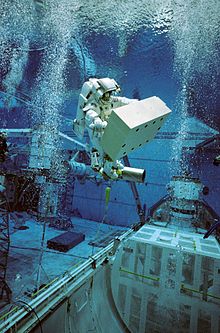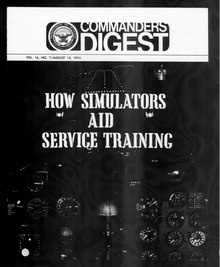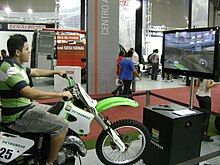
A | B | C | D | E | F | G | H | CH | I | J | K | L | M | N | O | P | Q | R | S | T | U | V | W | X | Y | Z | 0 | 1 | 2 | 3 | 4 | 5 | 6 | 7 | 8 | 9
| Part of a series on |
| Research |
|---|
 |
| Philosophy portal |
A simulation is an imitative representation of a process or system that could exist in the real world.[1][2][3] In this broad sense, simulation can often be used interchangeably with model.[2] Sometimes a clear distinction between the two terms is made, in which simulations require the use of models; the model represents the key characteristics or behaviors of the selected system or process, whereas the simulation represents the evolution of the model over time.[3] Another way to distinguish between the terms is to define simulation as experimentation with the help of a model.[4] This definition includes time-independent simulations. Often, computers are used to execute the simulation.
Simulation is used in many contexts, such as simulation of technology for performance tuning or optimizing, safety engineering, testing, training, education, and video games. Simulation is also used with scientific modelling of natural systems or human systems to gain insight into their functioning,[5] as in economics. Simulation can be used to show the eventual real effects of alternative conditions and courses of action. Simulation is also used when the real system cannot be engaged, because it may not be accessible, or it may be dangerous or unacceptable to engage, or it is being designed but not yet built, or it may simply not exist.[6]
Key issues in modeling and simulation include the acquisition of valid sources of information about the relevant selection of key characteristics and behaviors used to build the model, the use of simplifying approximations and assumptions within the model, and fidelity and validity of the simulation outcomes. Procedures and protocols for model verification and validation are an ongoing field of academic study, refinement, research and development in simulations technology or practice, particularly in the work of computer simulation.
Classification and terminology


Historically, simulations used in different fields developed largely independently, but 20th-century studies of systems theory and cybernetics combined with spreading use of computers across all those fields have led to some unification and a more systematic view of the concept.
Physical simulation refers to simulation in which physical objects are substituted for the real thing (some circles[7] use the term for computer simulations modelling selected laws of physics, but this article does not). These physical objects are often chosen because they are smaller or cheaper than the actual object or system.
Interactive simulation is a special kind of physical simulation, often referred to as a human-in-the-loop simulation, in which physical simulations include human operators, such as in a flight simulator, sailing simulator, or driving simulator.
Continuous simulation is a simulation based on continuous-time rather than discrete-time steps, using numerical integration of differential equations.[8]
Discrete-event simulation studies systems whose states change their values only at discrete times.[9] For example, a simulation of an epidemic could change the number of infected people at time instants when susceptible individuals get infected or when infected individuals recover.
Stochastic simulation is a simulation where some variable or process is subject to random variations and is projected using Monte Carlo techniques using pseudo-random numbers. Thus replicated runs with the same boundary conditions will each produce different results within a specific confidence band.[8]
Deterministic simulation is a simulation which is not stochastic: thus the variables are regulated by deterministic algorithms. So replicated runs from the same boundary conditions always produce identical results.
Hybrid simulation (or combined simulation) corresponds to a mix between continuous and discrete event simulation and results in integrating numerically the differential equations between two sequential events to reduce the number of discontinuities.[10]
A stand-alone simulation is a simulation running on a single workstation by itself.
A distributed simulation is one which uses more than one computer simultaneously, to guarantee access from/to different resources (e.g. multi-users operating different systems, or distributed data sets); a classical example is Distributed Interactive Simulation (DIS).[11]
Parallel simulation speeds up a simulation's execution by concurrently distributing its workload over multiple processors, as in High-Performance Computing.[12]
Interoperable simulation is where multiple models, simulators (often defined as federates) interoperate locally, distributed over a network; a classical example is High-Level Architecture.[13][14]
Modeling and simulation as a service is where simulation is accessed as a service over the web.[15]
Modeling, interoperable simulation and serious games is where serious game approaches (e.g. game engines and engagement methods) are integrated with interoperable simulation.[16]
Simulation fidelity is used to describe the accuracy of a simulation and how closely it imitates the real-life counterpart. Fidelity is broadly classified as one of three categories: low, medium, and high. Specific descriptions of fidelity levels are subject to interpretation, but the following generalizations can be made:
- Low – the minimum simulation required for a system to respond to accept inputs and provide outputs
- Medium – responds automatically to stimuli, with limited accuracy
- High – nearly indistinguishable or as close as possible to the real system
A synthetic environment is a computer simulation that can be included in human-in-the-loop simulations.[19]
Simulation in failure analysis refers to simulation in which we create environment/conditions to identify the cause of equipment failure. This can be the best and fastest method to identify the failure cause.
Computer simulation
A computer simulation (or "sim") is an attempt to model a real-life or hypothetical situation on a computer so that it can be studied to see how the system works. By changing variables in the simulation, predictions may be made about the behaviour of the system. It is a tool to virtually investigate the behaviour of the system under study.[3]
Computer simulation has become a useful part of modeling many natural systems in physics, chemistry and biology,[20] and human systems in economics and social science (e.g., computational sociology) as well as in engineering to gain insight into the operation of those systems. A good example of the usefulness of using computers to simulate can be found in the field of network traffic simulation. In such simulations, the model behaviour will change each simulation according to the set of initial parameters assumed for the environment.
Traditionally, the formal modeling of systems has been via a mathematical model, which attempts to find analytical solutions enabling the prediction of the behaviour of the system from a set of parameters and initial conditions. Computer simulation is often used as an adjunct to, or substitution for, modeling systems for which simple closed form analytic solutions are not possible. There are many different types of computer simulation, the common feature they all share is the attempt to generate a sample of representative scenarios for a model in which a complete enumeration of all possible states would be prohibitive or impossible.
Several software packages exist for running computer-based simulation modeling (e.g. Monte Carlo simulation, stochastic modeling, multimethod modeling) that makes all the modeling almost effortless.
Modern usage of the term "computer simulation" may encompass virtually any computer-based representation.
Computer science
In computer science, simulation has some specialized meanings: Alan Turing used the term simulation to refer to what happens when a universal machine executes a state transition table (in modern terminology, a computer runs a program) that describes the state transitions, inputs and outputs of a subject discrete-state machine.[21] The computer simulates the subject machine. Accordingly, in theoretical computer science the term simulation is a relation between state transition systems, useful in the study of operational semantics.
Less theoretically, an interesting application of computer simulation is to simulate computers using computers. In computer architecture, a type of simulator, typically called an emulator, is often used to execute a program that has to run on some inconvenient type of computer (for example, a newly designed computer that has not yet been built or an obsolete computer that is no longer available), or in a tightly controlled testing environment (see Computer architecture simulator and Platform virtualization). For example, simulators have been used to debug a microprogram or sometimes commercial application programs, before the program is downloaded to the target machine. Since the operation of the computer is simulated, all of the information about the computer's operation is directly available to the programmer, and the speed and execution of the simulation can be varied at will.
Simulators may also be used to interpret fault trees, or test VLSI logic designs before they are constructed. Symbolic simulation uses variables to stand for unknown values.
In the field of optimization, simulations of physical processes are often used in conjunction with evolutionary computation to optimize control strategies.
Simulation in education and training

Simulation is extensively used for educational purposes. It is used for cases where it is prohibitively expensive or simply too dangerous to allow trainees to use the real equipment in the real world. In such situations they will spend time learning valuable lessons in a "safe" virtual environment yet living a lifelike experience (or at least it is the goal). Often the convenience is to permit mistakes during training for a safety-critical system.
Simulations in education are somewhat like training simulations. They focus on specific tasks. The term 'microworld' is used to refer to educational simulations which model some abstract concept rather than simulating a realistic object or environment, or in some cases model a real-world environment in a simplistic way so as to help a learner develop an understanding of the key concepts. Normally, a user can create some sort of construction within the microworld that will behave in a way consistent with the concepts being modeled. Seymour Papert was one of the first to advocate the value of microworlds, and the Logo programming environment developed by Papert is one of the most well-known microworlds.
Project management simulation is increasingly used to train students and professionals in the art and science of project management. Using simulation for project management training improves learning retention and enhances the learning process.[22][23]
Social simulations may be used in social science classrooms to illustrate social and political processes in anthropology, economics, history, political science, or sociology courses, typically at the high school or university level. These may, for example, take the form of civics simulations, in which participants assume roles in a simulated society, or international relations simulations in which participants engage in negotiations, alliance formation, trade, diplomacy, and the use of force. Such simulations might be based on fictitious political systems, or be based on current or historical events. An example of the latter would be Barnard College's Reacting to the Past series of historical educational games.[24] The National Science Foundation has also supported the creation of reacting games that address science and math education.[25] In social media simulations, participants train communication with critics and other stakeholders in a private environment.
In recent years, there has been increasing use of social simulations for staff training in aid and development agencies. The Carana simulation, for example, was first developed by the United Nations Development Programme, and is now used in a very revised form by the World Bank for training staff to deal with fragile and conflict-affected countries.[26]
Military uses for simulation often involve aircraft or armoured fighting vehicles, but can also target small arms and other weapon systems training. Specifically, virtual firearms ranges have become the norm in most military training processes and there is a significant amount of data to suggest this is a useful tool for armed professionals.[27]
Virtual simulation
A virtual simulation is a category of simulation that uses simulation equipment to create a simulated world for the user. Virtual simulations allow users to interact with a virtual world. Virtual worlds operate on platforms of integrated software and hardware components. In this manner, the system can accept input from the user (e.g., body tracking, voice/sound recognition, physical controllers) and produce output to the user (e.g., visual display, aural display, haptic display) .[28] Virtual simulations use the aforementioned modes of interaction to produce a sense of immersion for the user.
Virtual simulation input hardware

There is a wide variety of input hardware available to accept user input for virtual simulations. The following list briefly describes several of them:
Zdroj:https://en.wikipedia.org?pojem=SimulationText je dostupný za podmienok Creative Commons Attribution/Share-Alike License 3.0 Unported; prípadne za ďalších podmienok. Podrobnejšie informácie nájdete na stránke Podmienky použitia.
Antropológia
Aplikované vedy
Bibliometria
Dejiny vedy
Encyklopédie
Filozofia vedy
Forenzné vedy
Humanitné vedy
Knižničná veda
Kryogenika
Kryptológia
Kulturológia
Literárna veda
Medzidisciplinárne oblasti
Metódy kvantitatívnej analýzy
Metavedy
Metodika
Text je dostupný za podmienok Creative
Commons Attribution/Share-Alike License 3.0 Unported; prípadne za ďalších
podmienok.
Podrobnejšie informácie nájdete na stránke Podmienky
použitia.
www.astronomia.sk | www.biologia.sk | www.botanika.sk | www.dejiny.sk | www.economy.sk | www.elektrotechnika.sk | www.estetika.sk | www.farmakologia.sk | www.filozofia.sk | Fyzika | www.futurologia.sk | www.genetika.sk | www.chemia.sk | www.lingvistika.sk | www.politologia.sk | www.psychologia.sk | www.sexuologia.sk | www.sociologia.sk | www.veda.sk I www.zoologia.sk
